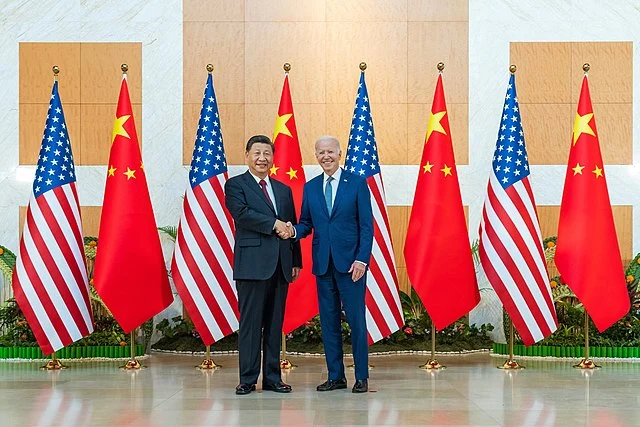The rise of China as a global power has transformed the dynamics of international relations, particularly in the Asia-Pacific region. With its expanding economic might, military modernization, and assertive foreign policy, China has emerged as a formidable competitor to the United States. As a result, the question arises: Can the US deter China in Asia?
Power Dynamics in Asia
To understand the US-China power dynamic in Asia, it is essential to examine various aspects. The United States has long been a dominant force in the region, with longstanding alliances, a military presence, and a network of regional partnerships.
On the other hand, China’s rapid economic growth and military modernization have enabled it to project power beyond its borders. It has become a leading trading partner for many Asian countries, investing heavily in infrastructure projects through initiatives like the Belt and Road Initiative. China’s assertiveness in the South China Sea, territorial disputes, and increasing military capabilities have raised concerns among neighboring nations and the US.

Military Capabilities
One crucial aspect of deterrence is military capabilities. The United States maintains a significant military presence in Asia, with a network of military bases, forward-deployed assets, and alliances like Japan and South Korea. Its robust naval capabilities and advanced technology, including aircraft carriers, stealth fighters, and missile defense systems, provide substantial deterrence potential.
However, China has also made substantial investments in its military, focusing on areas such as anti-access/area denial (A2/AD) capabilities, naval expansion, and cyber warfare. It has developed advanced missiles, anti-ship ballistic missiles, and a rapidly growing naval fleet. While China’s military may not yet match the United States in overall capability, its regional influence is expanding, challenging American military dominance in Asia.
Economic Interdependence
Economic interdependence plays a crucial role in shaping power dynamics and deterrence strategies. China has become a vital trading partner for many countries in Asia, with its economic influence reaching unprecedented levels. This economic leverage allows China to employ both carrot and stick approaches, offering economic incentives while exerting pressure on nations to align with its interests.
The United States also has significant economic ties with Asia, but China’s economic prowess and extensive trade networks have made it challenging for the US to apply unilateral economic pressure effectively. However, the US can leverage its economic influence through regional partnerships, trade agreements, and targeted sanctions to limit China’s expansion and increase its own deterrence capabilities.
Regional Alliances and Partnerships
The US has a long history of alliances and partnerships in Asia, which have been a cornerstone of its deterrence strategy. Treaty alliances with countries like Japan, South Korea, Australia, and the Philippines provide a strong deterrent effect against potential aggression from China. These alliances enable military cooperation, information sharing, and collective defense.
Moreover, the US has been actively engaging with regional multilateral organizations such as ASEAN (Association of Southeast Asian Nations) and forging partnerships with countries like India, Vietnam, and Indonesia to counterbalance China’s influence. By strengthening these alliances and partnerships, the US can enhance its deterrence capabilities and provide a united front against China’s assertiveness.
Deterrence Strategies
While the US faces a formidable challenge in deterring China in Asia, it possesses several strategies to maintain its influence and counter China’s assertiveness.
Strengthening Alliances and Partnerships
One crucial aspect of deterring China is the consolidation and reinforcement of alliances and partnerships in the region. The United States should continue to invest in its relationships with key allies like Japan, South Korea, and Australia, enhancing military cooperation, joint exercises, and information sharing. Additionally, building stronger partnerships with emerging regional powers such as India, Vietnam, and Indonesia can help balance China’s influence.
Multilateral Engagement and Institutions
Active engagement in regional multilateral organizations like ASEAN is vital for the US to shape the regional power balance. By participating in forums that promote dialogue, cooperation, and the rule of law, the US can help shape regional norms and provide a platform to address contentious issues. Strengthening regional institutions can contribute to collective security and deterrence against potential Chinese aggression.
Economic Statecraft and Trade Agreements
The United States should leverage its economic influence to counterbalance China’s economic dominance in the region. It can achieve this through trade agreements that foster economic interdependence with partner nations and promote a level playing field. Targeted sanctions and export controls can be employed to curb China’s access to advanced technologies with potential military applications. Moreover, the US should promote alternative infrastructure investment initiatives that prioritize transparency, sustainability, and economic development without burdening recipient countries with excessive debt.
Technology and Innovation
Maintaining technological superiority is vital for effective deterrence. The US should continue investing in research and development, particularly in emerging technologies such as artificial intelligence, cyber capabilities, and quantum computing. Promoting innovation and safeguarding intellectual property rights can help ensure that the US maintains its competitive edge in critical sectors, reducing reliance on China for advanced technologies.
Strategic Communication and Information Campaigns
Countering China’s influence in the information space is crucial for effective deterrence. The US should invest in strategic communication and information campaigns to promote democratic values, highlight human rights concerns, and counter disinformation efforts by China. Strengthening cybersecurity cooperation among allies and partners is essential to protect critical infrastructure and deter cyber threats originating from China.
Conclusion
Deterring China in Asia is a complex and multi-faceted task for the United States. While China’s rise poses significant challenges, the US possesses substantial capabilities and strategies to counterbalance China’s influence. Strengthening alliances and partnerships, engaging in multilateral institutions, employing economic statecraft, prioritizing technology and innovation, and conducting strategic communication campaigns are all critical components of an effective deterrence strategy. By pursuing a comprehensive approach that combines military, economic, diplomatic, and informational elements, the US can maximize its ability to shape the power dynamics in Asia and maintain a stable and prosperous region.







